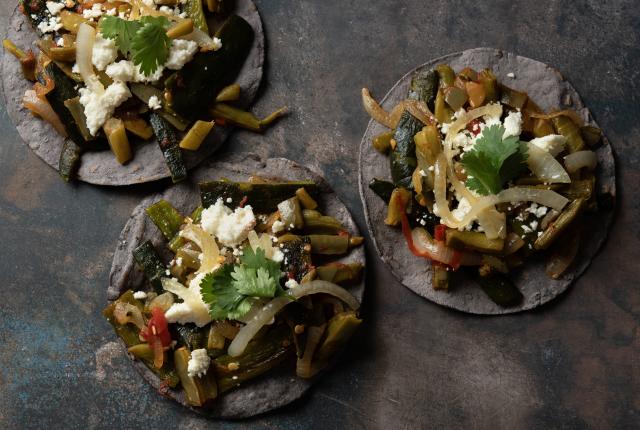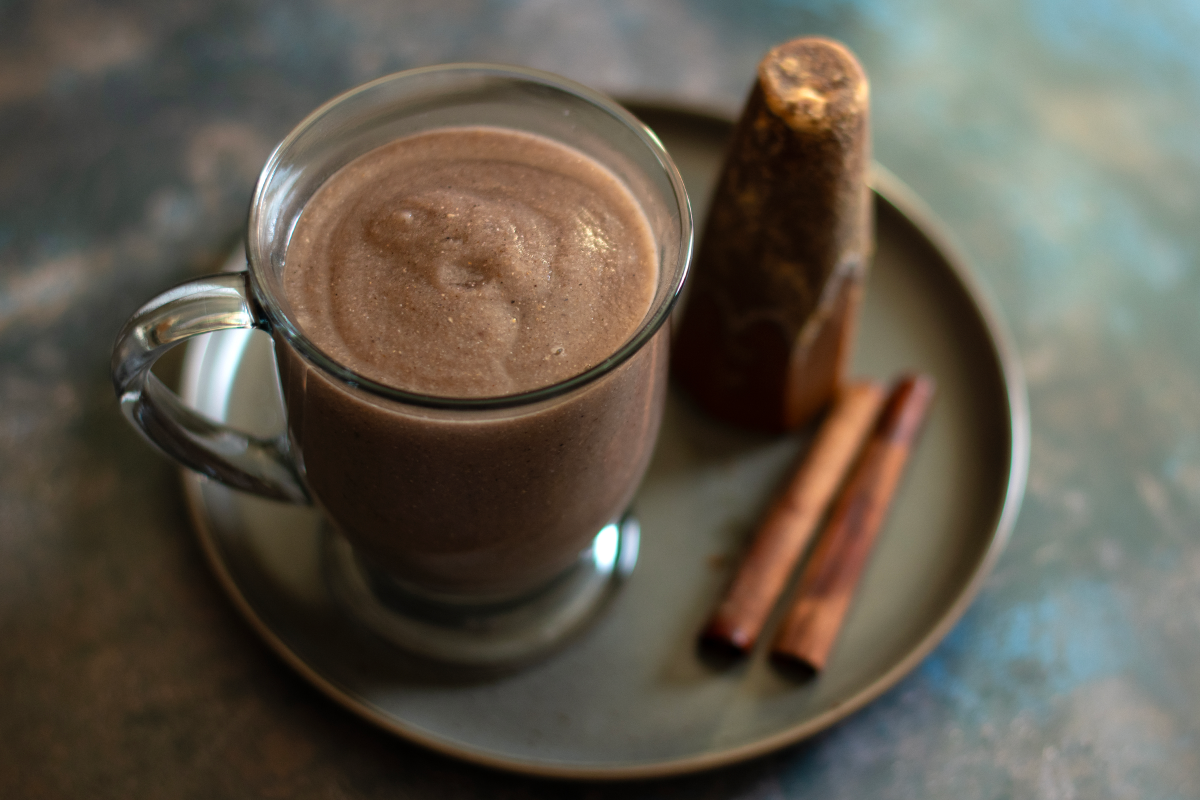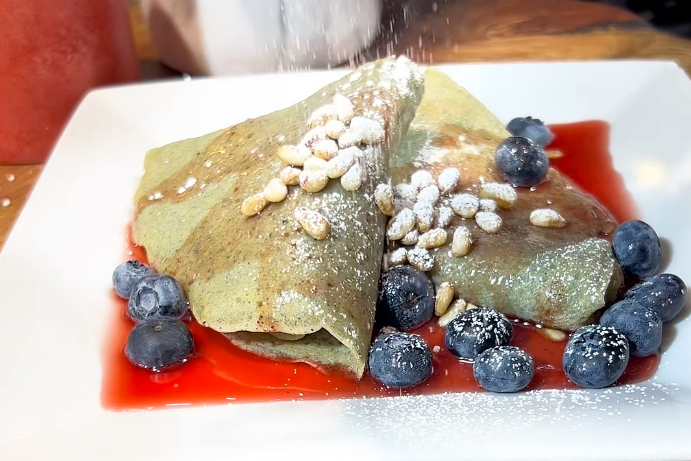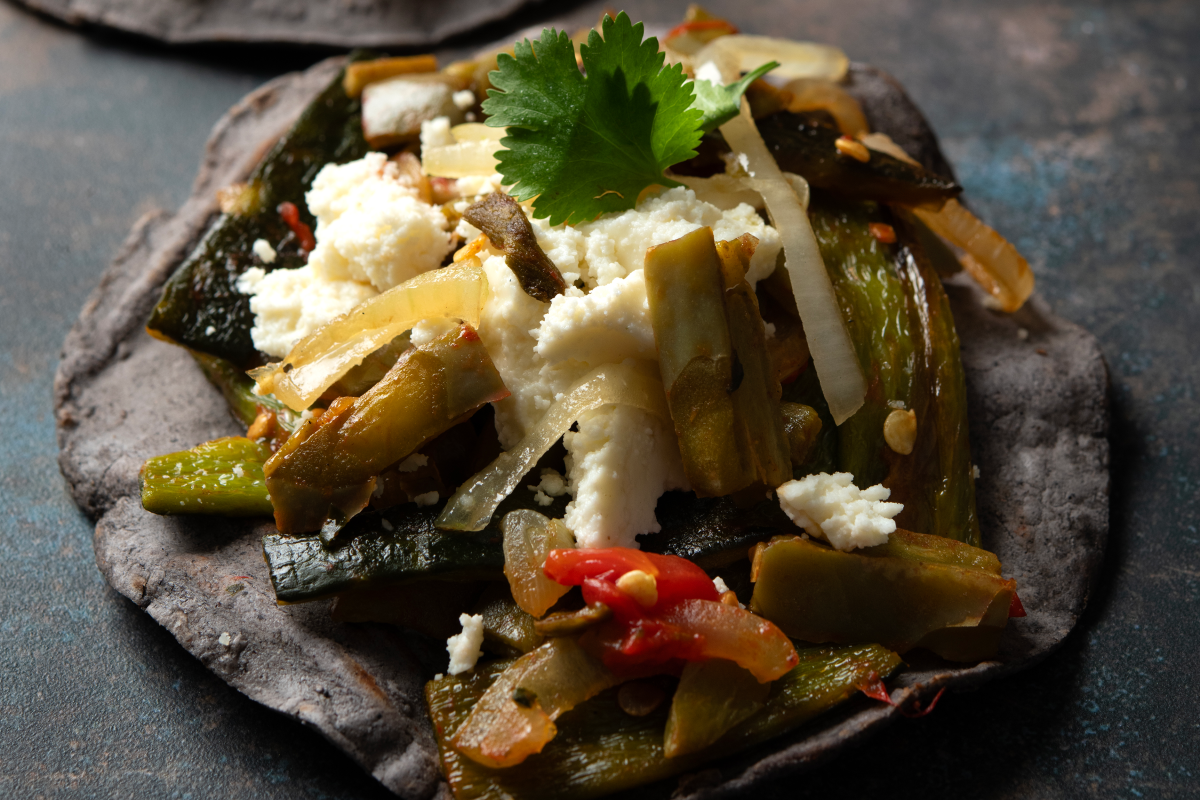A LATE SUMMER SATURDAY MORNING at the Santa Fe Farmers’ Market is an olfactory experience. There’s the unmistakable aroma of green chiles roasting over open flame, herbaceous notes from marigold garlands, and, near the front entrance of the pavilion, sweet and nutty wafts of griddled blue corn pupusas.
“You can really smell the freshness of that blue corn masa,” marvels La Mesa Farms co-owner Mesa Ruiz while flipping a bean and cheese-stuffed disk on his comal. “It’s magical.”
Mesa and his wife Molly’s 20-acre farm in Dixon specializes in blue corn. In addition to their popular pupusas, they sell dried blue corn posole, masa harina, atole mix, and an elixir of roasted corn, chocolate, and chile. Although Mesa has been a blue corn farmer for almost three decades, the couple see themselves more as stewards.
“There’s a sacred contract between the people who grow blue corn, the land, and their community,” says Molly. “Our highest priority is to honor that relationship.” At La Mesa, that means using organic growing methods and ensuring the survival of heritage seeds—lineages bred for decades to flourish in the soil and climate of northern New Mexico.
“Blue corn seeds are only viable for seven years,” Mesa explains. “As the farmers in our valley are getting old and passing away, it’s becoming harder for their families to properly care for these seeds that they have planted for generations. Our neighbors bring them to us so we can keep them going, with the hope that one day their grandchildren will come take them back.”
WHILE THE QUESTION IS NOT QUITE AS common as “Red or green?,” diners in New Mexico are often presented with the choice to go blue. Peruse the menu at local eateries that emphasize regional ingredients and you’re more than likely to spot the ancient grain, whether it’s infusing blue corn enchiladas, blue corn pancakes, or even blue corn-lavender doughnuts.
The region’s Indigenous peoples first cultivated and consumed blue corn, a staple of Southwest cuisine, nearly four thousand years ago after securing seeds through trade networks into Mesoamerica. Its hardy, drought-resistant nature makes blue corn ideally suited to New Mexico’s arid climate, as well as for dry storage. As flint corns, blue varieties are hard-kerneled, requiring processing and cooking. That’s one reason why preparations like blue corn tortillas, mush, and hominy are so prevalent in New Mexico.
More recently, blue corn has achieved an elevated—almost trendy—status at many of the state’s upscale or tourist-oriented restaurants, where locavore chefs extol its earthy flavor, visual appeal, and varietal novelty. “Blue corn is super integral to what we do,” says James Beard Award–semifinalist Christopher Bethoney, executive chef at Campo, in Los Ranchos de Albuquerque. The restaurant’s recent blue corn panna cotta special was a twist on a traditional atole, a roasted blue corn beverage similar to porridge. “It was a cool way to bring atole to New Mexico in a different form.”
But New Mexicans’ appreciation for blue corn is more than husk-deep. Beyond its robust taste and striking indigo hue, blue corn has deep-rooted cultural significance. Its seeds, dishes, and traditions are passed down through generations, fostering delicious connections between our past and present.
FOR TWO NORTHERN NEW MEXICO CHEFS turned culinary instructors, teaching the next generation how to cook with blue corn is just as important as growing it. “Our traditional recipes are getting lost,” says Adonais Nité Márquez. “I really feel that way.” After many years of cooking at the Taos Inn, Márquez recently became a high school culinary teacher for the Peñasco Independent School District at Picuris Pueblo.
In a brand-new, fully equipped industrial kitchen, Márquez teaches kitchen safety, knife work, and regional dishes. “I try to show the kids things from their culture, stuff their grandma and grandpa would have made,” says Márquez, who grew up eating blue corn dishes prepared by his Hispano and Indigenous grandparents. His recipes include blue corn and juniper ash pancakes topped with toasted piñon nuts, blue corn-crusted rainbow trout, and blue corn biscochitos. “We need to keep our food traditions alive,” he says. “It’s what connects us.”
Nearby, at a blue corn masa-making workshop at the Kalpulli Taos ceremony grounds, Andrew Fleisher Ortivez methodically crushes roasted sapphire kernels into a coarse powder using a basalt metate and mano stone. “During the pandemic, I grew blue corn in my garden,” says the Taos-based chef, who owns Nixta Kitchen catering with his partner, Amber Rose Ashodian. “I became determined to make them into tortillas, the traditional way.”
Soon, he and Ashodian began partnering with local pueblos and organizations to offer four-hour Nixtamal workshops, where participants learn how to take blue corn from cob to comal and prepare a feast of tacos filled with locally sourced ingredients like nopales, Anasazi beans, and purslane.
“I’m interested in food sovereignty, which is about connecting with one’s own ancestral foods,” he says. “We start the workshops by having everyone talk about their relationships to these foods. It shows there’s a strong sense of being cut off from their ancestral foods, but also that there’s a desire for reconnection.”
One of the most important culinary lessons in his class is that of nixtamalization: steeping corn in an alkaline solution to remove its outer layer. “This is usually done with calcium hydroxide, but traditionally, Pueblo peoples used juniper ash,” Fleisher Ortivez says. The process makes corn easier to grind, enhances its flavor, and boosts its inherent nutritional value.
“They say blue corn is healthier,” says Fleisher Ortivez, noting that the fiber- and niacin-rich vegetable’s distinctive color derives from anthocyanins, a type of antioxidant. Like other blue-hued superfoods, these antioxidants are believed to have powerful anti-inflammatory properties that help lower blood sugar and reduce the risk of cardiovascular disease, type 2 diabetes, and cancer. “But for me, what makes it more nutritious is that I know this corn is grown in a less industrialized way—organically, without GMOs, using traditional practices,” he says.
A SOFT GRAY-BLUE HUE TINGES MANY OF THE lunch orders at the Indian Pueblo Kitchen, located inside the Indian Pueblo Cultural Center (IPCC), in Albuquerque. Customers dunk blue cornmeal-battered onion rings and fried Kool-Aid marinated pickles into green chile ranch dressing. Warm blue corn muffins arrive with bowls of elk chili. Cups of hearty atole come topped with currants, piñon nuts, sunflower seeds, and blueberries.
“We used blue corn all the time growing up on Laguna,” says Josh Aragon, the cultural center’s sous chef who hails from Laguna Pueblo, “often to thicken our stews or for piki bread,” a paper-thin traditional bread.
For Indigenous people, corn is central to the agricultural practice of interplanting corn, beans, and squash, known as the Three Sisters. In the Southwest, blue corn also holds spiritual significance, appearing in ceremonies, rituals, and creation stories. For Acoma and Zuni people, it also represents the direction west and generally symbolizes sustenance and resilience against colonization. IPCC is securing that legacy by cultivating blue corn in the on-site Resilience Garden, dedicated to traditional Pueblo agriculture and cuisine. “I’m looking forward to cooking that corn this fall,” Aragon says.
For Aragon, both the classic and contemporary blue corn dishes at Indian Pueblo Kitchen share a common purpose. “My favorite thing is seeing our customers’ faces light up,” he says. “Maybe the dish reminds them of something they had growing up. Or maybe they’re trying something totally new.”
Senior Editor Candolin Cook doesn’t usually drink beer, but when she does, she prefers Bow & Arrow’s Denim Tux, a pilsner made with blue corn.
While Adonais Nité Márquez was growing up in northern New Mexico, his grandmother transformed blue corn from her garden into atole, a thick, nutty-sweet, nutrient-filled elixir. “I still drink it at night to aid with digestion,” Márquez says.
- 4 cups water, divided
- 2 cinnamon sticks
- 1 cup fine-ground blue cornmeal
- 3 tablespoons piloncillo (Mexican brown sugar)
- Honey to taste
- Sprinkle of cinnamon, optional
- 1 dash salt, optional
Serves 1
- In a small pot, simmer 2 cups water with cinnamon sticks.
- In a separate bowl, combine blue cornmeal and remaining 2 cups cold water, mix well.
- Remove cinnamon sticks from simmering water and add the cornmeal-water mixture, mix well.
- Mix in the piloncillo. Add honey and a sprinkle of cinnamon and salt to taste.
Ever the teacher, Adonais Nité Márquez provides instructional video recipes featuring Indigenous- and New Mexican–inspired comfort foods on his popular Instagram page (@chefnite2015)—including these delicate blue corn crepes.
FOR PRICKLY PEAR SYRUP
- 1 cup prickly pear puree (such as the Perfect Purée’s, available online)
- ½ cup water
- 1 cup sugar
- 1 tablespoon lemon juice
FOR CREPES
- ¼ cup blue cornmeal
- ¾ cup Blue Bird Flour
- 1 tablespoon sugar
- 1 teaspoon juniper ash, optional
- 1 cup milk
- 2 eggs
- 2 tablespoons melted butter
- 1 teaspoon vanilla
- Olive oil, for pan
Makes about 8 crepes
FOR PRICKLY PEAR SYRUP
- In a small pot, combine all ingredients and bring to a simmer until thickened (around 15 minutes). Strain and let cool in the refrigerator.
FOR CREPES
- In a medium-size bowl, combine dry ingredients, mix well.
- In a separate medium bowl, combine wet ingredients, mix well.
- Add the dry mixture to the wet, mixing well to ensure no lumps. Rest for a few minutes.
- Heat a nonstick or crepe pan greased with olive oil on medium. Ladle a little batter into the center and swirl to create a thin, even layer.
- Cook for 1 minute or until the edges lift slightly. Flip over and cook for another 30 seconds. Place on a plate and repeat with the remaining batter.
- Assemble crepes on a plate and drizzle with syrup and your choice of topping (honey, whipped cream, berries, piñon nuts, and/or powdered sugar).
Chef Andrew Fleisher Ortivez sources his blue corn from local farms such as Owl Peak, in La Madera, and La Mesa, in Dixon. He says an online- or store-bought bag of Masienda’s heirloom blue corn masa harina is a good alternative.
FOR TORTILLAS
- 2 cups blue corn masa harina
- 1½ cups water, divided
- Special equipment: a tortilla press (or a cutting board and heavy book).
FOR FILLING
- 1 pound nopales, de-spined and sliced into strips
- Salt and pepper
- 3 poblano peppers
- 1 to 2 tablespoons vegetable oil
- ½ sweet onion, sliced
- 3 cloves garlic, chopped
- 2 Roma tomatoes, sliced
- 2 teaspoon chile powder
- Cilantro, additional onion, and queso fresco, for garnish
Makes 6-8 tacos
FOR TORTILLAS
- Mix masa harina with half the water.
- Work in the remaining water a little at a time. When dough is the consistency of Play-Doh, make a small ball of dough with your hands—if the edges crack, it’s too dry; if the dough is pasty and sticks to your hands, it’s too wet. Adjust dough moisture if needed with extra water or masa harina.
- Heat a dry griddle on medium-high heat.
- From the lump of masa, tear off and roll a ball approximately the size of a ping-pong ball. (Do not preshape the masa balls ahead of time, they will dry out too fast.)
- Cut a thin resealable plastic bag into 2 squares the same size as your tortilla press. Place one below and one above your masa ball and press the dough into a flat thin circle.
- Gently pull the plastic sheets away and place the dough disk on your griddle. Sear the first side for about 30 seconds, flip, and cook for another minute. Flip back to the first side and press the tortilla with a spatula to encourage it to puff. The puff fills the tortilla with steam and cooks the inside.* Once inflated, remove from heat and place in a tortilla warmer or covered basket.
*No puff, no worries! The tortillas will steam through in the basket. Try adjusting the moisture of your dough or the thickness of the press—thinner tortillas puff easier.
FOR FILLING
- Add nopales to a pot with enough water to cover and a pinch of salt. Bring to a boil, then lower heat to a gentle boil and cook for about 15 minutes, or until the slime cooks off and the cactus is tender. Drain water and set aside.
- Blister and blacken the skin of the poblanos over a grill or in a broiler. Place in a covered bowl for about 5 to 10 minutes to sweat, then peel the skins off and cut into ½-inch-wide slices.
- Heat a frying pan with oil over medium heat. Add onion and sauté until translucent. Add the garlic and stir.
- Add nopales and poblanos to the pan and cook until browned.
- Add tomatoes and chile powder to pan, and cook until the tomatoes break down and become saucy.
- Serve in a warm tortilla with your choice of toppings.









